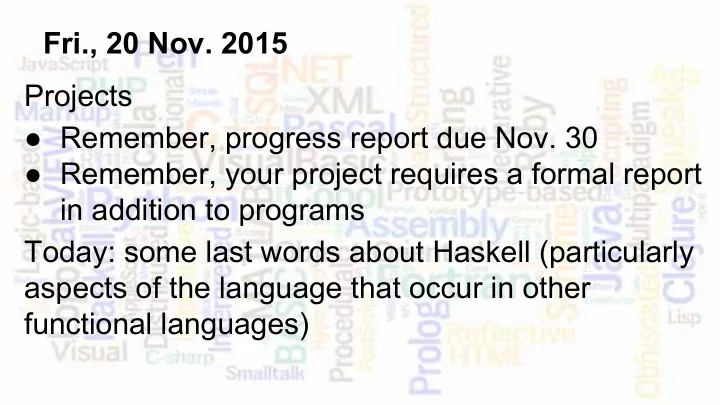

Fri., 20 Nov. 2015 Projects ● Remember, progress report due Nov. 30 ● Remember, your project requires a formal report in addition to programs Today: some last words about Haskell (particularly aspects of the language that occur in other functional languages)
More About Haskell -- “let” What is “ let ”? It’s a binding/scoping mechanism; its main purpose is to allow us to give names to values and expressions to make it easier to write programs. For instance, here’s a long, messy expression (it was all typed on one line, but appears “wrapped” on this slide): Prelude> [head "abcde","abcde"!!((length "abcde") `div` 2),last "abcde"] "ace"
More About Haskell -- “let” Prelude> :set +m -- turn on multiline Prelude> let Prelude| s="abcde" Prelude| l=length s Prelude| in [head s,s!!(l `div` 2),last s] "ace" The construction “ let bindings in expression ” means “let the following bindings hold inside this expression”. NOTE: scope is limited! Prelude> s <interactive>:9:1: Not in scope: ‘s’
“let” in Other Languages Most functional programming languages have something similar to the “let” function. In Common Lisp we can write: [21]> (defun f (x) (let ( (xsq (* x x)) (xcube (* x x x))) (+ x xsq xcube) ) ) F Let xsq stand for x 2 , let xcube stand for x 3 in [22]> (f 2) the expression “ x + xsq + xcube ” 14 [23]> (f 3) 39
“let” in Other Languages And of course, we have seen the “let” instruction in JavaScript: "use strict"; “ max ” and “ sum ” function f(x) { are visible only let max = x * x; within function f ; let sum = 0; “ i ” is visible only for (let i = 0; i < max; i++) { within the “ for ” sum += i; loop. } return sum; } console.log("f(5) = " + f(5));
The “map” Function From the very first functional language, LISP, up to the present, one operation has been nearly universal: the “map” function. Here are some examples in Haskell: Prelude> let x = [1.0..10.0] Prelude> map sqrt x [1.0,1.414,1.732,2.0,2.236,2.449,2.645,2.828,3.0,3.162] Prelude> map succ x [2.0,3.0,4.0,5.0,6.0,7.0,8.0,9.0,10.0,11.0] Prelude> map pred x [0.0,1.0,2.0,3.0,4.0,5.0,6.0,7.0,8.0,9.0] Use “map” to apply a function to every element of a list.
The “map” Function We can map any function to a list as long as the list elements are of the appropriate type for the function: Prelude> let y = ["this","is","a","list","of","strings"] Prelude> map length y [4,2,1,4,2,7] Prelude> map head y "tialos" Prelude> let z = [1..10] Prelude> let f x y = x+y Prelude> map (f 5) z -- NOTE: f 5 is a curried function [6,7,8,9,10,11,12,13,14,15]
The “map” Function Here is the “map” function in Python: >>> from math import * >>> x = range(1,11) >>> map(sqrt,x) [1.0,1.414,1.732,2.0,2.236,2.449,2.645,2.828,3.0,3.162] >>> y = ["this","is","a","list","of","strings"] >>> map(len,y) In the last example we define an [4, 2, 1, 4, 2, 7] “anonymous” function that maps a string “x” into the result of a >>> map(lambda x:x.find("i"),y) “find” operation on x. Python has [2, 0, -1, 1, -1, 3] lambda expressions!
The “map” Function Here is the “map” function in Common Lisp (where it is called “mapcar”): [16]> (mapcar 'sqrt '(1 2 3 4 5)) (1 1.4142135 1.7320508 2 2.236068) [17]> (defun f(x) (* 10 (+ x 3))) F [18]> (mapcar 'f '(1 2 3 4 5 6)) (40 50 60 70 80 90)
Back to Haskell: “fold” Operations Another very common operation in functional programming languages is the “fold” or “reduce” operator. It’s like inserting an operator between successive elements in the list. In Haskell, we can write things like: Prelude> let x = [3,4,7,2,1,8,9,10,6] Same as 3*4*7*2*1*8*9*10*6 Prelude> foldl (*) 1 x 725760 Prelude> foldl (+) 0 x Same as 3+4+7+2+1+8+9+10+6 50 More precisely, “ foldl ” evaluates left to right: (((3*4)*7)*2)*...
Back to Haskell: “fold” Operations When we use the “foldl” operation we have to specify what to do in the case of an empty list: foldl (*) 1 [1,2,3] Product begins at “1” = 1*1*2*3 foldl (+) 0 [1,2,3] Sum begins at “0” = 0+1+2+3
Back to Haskell: “fold” Operations One more example of “ foldl ”: Prelude> foldl (-) 0 [2,5,3,1] -11 = (((0 - 2) - 5) - 3) -1 For right-associative evaluation, use “ foldr ”: Prelude> foldr (^) 1 [3,2,2] 81 = 3 ^ (2 ^ (2 ^ 1))
Fold Operations in Other Languages >>> x = [3,5,7,2,1,6,7,2,3] >>> def f(x,y): ... return x*y ... In Python and some other >>> reduce(f,x) languages, the “fold” operator 52920 is named “reduce.” >>> def f(x,y): ... return x-y ... >>> reduce(f,x) -30
Recommend
More recommend